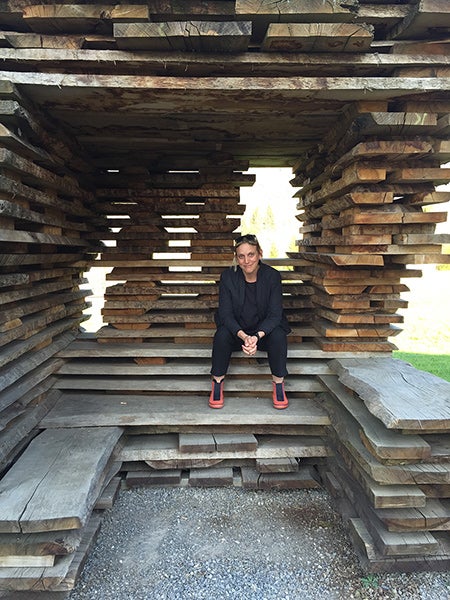Erin Moore makes a regular practice of melding architectural design with science. She has taught architecture classes at UO in collaboration with a chemist and a wood scientist. A practicing architect and teacher, she emphasizes the role of natural systems and environmental ethics in design processes. She has worked internationally to push the boundaries of design and construction.
So when the United Nations came calling, it wasn’t an unwelcome surprise for Moore, an associate professor in the Department of Architecture in the School of Architecture and Allied Arts.

Above: Associate Professor Erin Moore pauses in a stacked oak bus stop by Ensamble Architects in Krumbach, Austria, a rural community in Voralberg. The region is known for a high level of architectural design and for conscientious use of local construction materials. This bus stop is one in a series of bus stops in Krumbach that are designed by architects from around the world. Photo courtesy Erin Moore.
Moore is one of two Americans among 12 global experts in art, media, design, and architecture asked to contribute to the UN’s first “Experts' Summary Report on Harmony with Nature Addressing Earth Jurisprudence,” which was presented to the UN’s Division for Sustainable Development recently.
The UN asked the experts to help shape a discussion on “harmony with nature,” or the idea of human interconnectedness with natural systems. More specifically, they asked panelists to explore the “approaches, obstacles, recommendations, and priorities” to achieve “Earth jurisprudence,” the legal framework for the rights of nature.
Moore is a logical choice for the task. Her professional practice and teaching explore architecture in the context of environmental ethics, fossil fuel consumption, carbon sequestration, and climate change.
On November 21, she chaired a session at the UNESCO headquarters in Paris on “Citizenship, Ecology, and the Built Environment” for the symposium State of the Community: Citizens, Communities, and Multilayered Identities hosted by the Dhillon Marty Foundation.
“The choice to include artists and designers in the development of this project is radical and important,” Moore said of the UN report. “It places art and design right alongside law and philosophy as a framework for shaping cultural values.”
To further expand that framework, Moore invited students from previous studios to gather and generate ideas for the report.
She views the project as a natural extension of the UN’s mid-20th century advocacy for broader human rights.
“My goal is for the UN to make a declaration on the rights of nature just as it published the Universal Declaration of Human Rights in 1948. The global movement for the rights of nature is building on indigenous rights movements around the world,” Moore said.
Since the Industrial Revolution, nature “has been treated as a commodity that exists largely for the benefit of people,” the UN’s Harmony with Nature website stated. “[There] is a need to devise a more sustainable model for production, consumption and the economy [that] will require a new relationship with the Earth and with humankind's own existence.”
Other panels of contributors to the UN report represented the disciplines of earth-centered law, ecological economics, education, holistic science, humanities, philosophy/ethics, and theology. Moore’s UO colleague Craig Kauffman contributed to the report’s section on earth-centered law.
